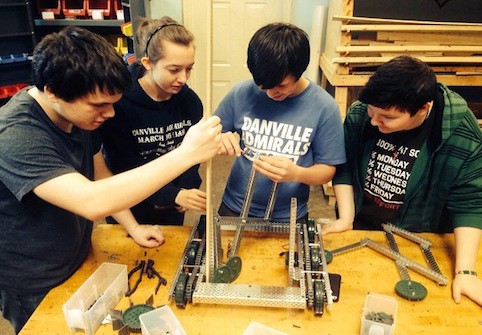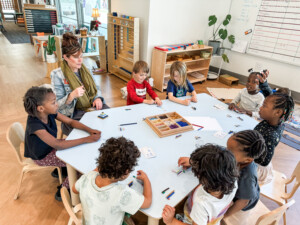The Transformational Leader

Carmen Coleman
“Anyone can hold the helm when the sea is calm.” -Publilius Syrus
During the last several years, I have continually asked, “What do students need to be well equipped for successful futures, and what kinds of experiences will help them most?” Although these have been looming questions since I started my teaching career, they were magnified when I became superintendent and actually handed students their diplomas. I saw the dismal statistics about college freshman retention rates come to life through conversations with recently graduated students who I might see around town. Knowing what their plans had been, I would ask how they liked college only to find out that they’d decided to “work second semester instead,” to “take some time off” or worse, some said they hadn’t gone at all. Although many factors were no doubt at play in these scenarios, what haunted me was the feeling that we – as educators – could’ve done more to ensure our students were better prepared for productive next steps.
Reform Or Transform?
Education reform has been at the center of discussion and debate in our country for more than 20 years. At this point, I can’t help but think that what we need is not reformation, but instead, transformation. To reform suggests that you make something better by improving upon something that already exists. This is what we have tried continually to do with schools – make the existing model better.
To transform, however, is something very different. To transform suggests that you begin to reimagine what could be, rethink what you accept as standard and create something new. I believe this is our challenge and our opportunity.
If transformation is the task at hand, the impact is far reaching. Once we create the school experience our students need, what might this mean for funding and policy? Can we still fund schools based on seat time? What about facilities? Should we still have long hallways and isolated classrooms filled with rows of desks? There are many factors to consider in a reimagined school, but perhaps the first we should consider is leadership.
Today’s School Leader
A Google search for “leadership research” yields 461,000,000 results. This is certainly a topic that has been studied. What is it that makes an effective leader, and specifically, an effective school or district leader? Immediately, when I think back to principals from my own school experiences, I can almost hear the rattling of keys. Although I know they certainly did a lot more than open doors and Coke machines, I have to think their days were consumed with management. This is not a criticism in any way. This, in fact, is much of what the Industrial Age model of school called for the leader to do – manage.
The reimagined experience for students requires a reimagined role for leaders, and in those places where school is starting to look very different, leadership takes a different shape.
A Few Examples
One principal I know is responsible for students in grade 6 through 12. She became very interested in the project-based approach last year and wanted her students to benefit. Not only did she arrange for training for her teachers, she took part in the training alongside the teachers and now, co-teaches a class where PBL is the central instructional mode. She is helping her teachers learn firsthand about project-based learning while also showing them it is safe to try new and different approaches. As a matter of fact, she shows that this is encouraged, and that it will be supported.
This principal is also very connected. Her personal learning network includes regularly taking part in Twitter chats. She continually shares ideas and resources with colleagues – even those not in her district – and is always looking to learn.
I know a superintendent who has inspired his district to embrace project-based learning and performance-based assessment. His teachers are, this year, implementing their own performance-based system even though they are still held accountable by state assessments. This superintendent knows his students need more than focus on a test-based curriculum. He also knows this could be risky, as the state assessments don’t necessarily align with deeper learning.
This same superintendent has traveled – along with teachers and principals – to High Tech High School in San Diego, to the Big Picture School in Nashville to various schools in NY on his journey to figure out what today’s learning experience needs to be.
One former principal, now an assistant superintendent, continually questions the function of designs found in schools, asking if they were designed for learning or for instruction. This leader also shared in a recent presentation that he faced tremendous adversity when, as a principal, he opened a school truly designed for learning, not simply for instructing.
This newly opened school was quite different from the Industrial Age model with which we are so familiar. So different, in fact, that parents even started a Facebook page calling for his removal as principal.
Thankfully, he persevered. He met with family after family. He listened, and he talked with them about the rationale behind the school’s way of doing business. Now, this is one of the most respected schools in his state, one that has a long waiting list of students wanting to get in.
What Is The Recipe?
Do these leaders still manage? You bet. However, they are not consumed with those tasks each day. They have organized their schools and districts so that management is efficient and effective, and so that it does not have to become their focus. Are they instructional leaders? Yes, but they are even more than that.
These are visionary leaders who are able to bring the vision to life. They are smart, collaborative, and they aren’t afraid of taking risks.
All of those mentioned have tremendous respect for their students and teachers, and the knowledge and experience they bring to the table. The middle school principal’s actions clearly communicated her belief in shared leadership, and that she also realized how important it is to have structures in place that will stand the test of time.
A Hope
I am not proposing another set of standards for school or district leaders. There are many ways to be a successful leader, and unique circumstances call for unique skills. Transformation requires a leader beyond one who can simply improve outcomes under the current circumstances. A system in need of transformation calls for a distinctive skill set – one that can survive and even help others to thrive in ambiguity. Unlike reform, transformation means grappling with an entirely new way of thinking. It means asking questions that perhaps haven’t been asked – questions many aren’t able to or interested in answering. Leading through transformation means navigating through unchartered waters. Waters that can often be challenging at best.
I have a much better idea today about the kinds of experiences students need for successful postsecondary futures. My question now has become, “What are those skills and dispositions that a leader might need today, in schools making the shift from the traditional model to one whose mission is to provide experiences that truly prepare students for successful futures in the 21st Century?” Those leaders described here certainly have those special talents. Talents that, I hope, will be in the highest demand in the years to come.
To learn more about preparing leaders, see:
- Design Thinking Course Trains Future EdLeaders
- How Should Principals Be Trained? Like MBAs? Like CEOs?
- Leadership Mindsets for Breakthrough Leaders
This post is part of our “Preparing Leaders for Deeper Learning” series. If you have thoughts about what today’s school leaders should know and be able to do and how they should be prepared, we’d love to hear from you. Contact [email protected] with the subject “Preparing Leaders” for more information.
 Carmen Coleman, formerly Superintendent of Danville Independent Schools, is now an associate clinical professor in Educational Leadership at the University of Kentucky. She can be reached through email at [email protected]
Carmen Coleman, formerly Superintendent of Danville Independent Schools, is now an associate clinical professor in Educational Leadership at the University of Kentucky. She can be reached through email at [email protected]



0 Comments
Leave a Comment
Your email address will not be published. All fields are required.